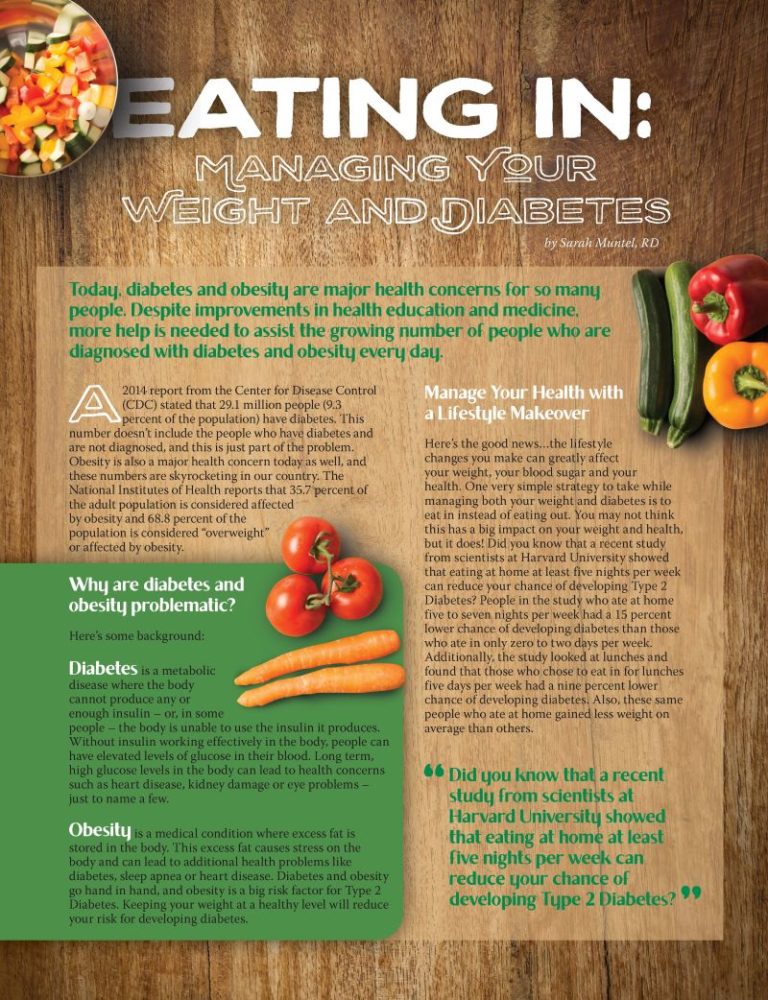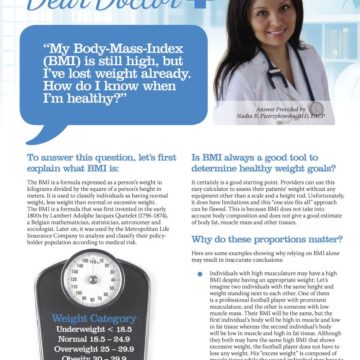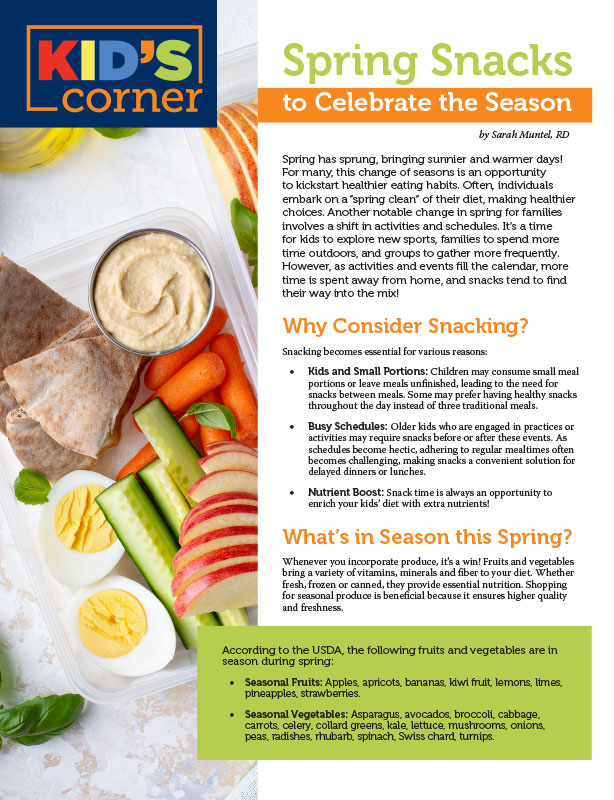Eating In: Managing Your Weight and Diabetes


by Sarah Muntel, RD
Fall 2016
Today, diabetes and obesity are major health concerns for so many people. Despite improvements in health education and medicine, more help is needed to assist the growing number of people who are diagnosed with diabetes and obesity every day.
A 2014 report from the Center for Disease Control (CDC) stated that 29.1 million people (9.3 percent of the population) have diabetes. This number doesn’t include the people who have diabetes and are not diagnosed, and this is just part of the problem. Obesity is also a major health concern today as well, and these numbers are skyrocketing in our country. The National Institutes of Health reports that 35.7 percent of the adult population is considered affected by obesity and 68.8 percent of the population is considered “overweight” or affected by obesity.
Why are diabetes and obesity problematic?
Here’s some background:
Diabetes is a metabolic disease where the body cannot produce any or enough insulin – or, in some people – the body is unable to use the insulin it produces. Without insulin working effectively in the body, people can have elevated levels of glucose in their blood. Long term, high glucose levels in the body can lead to health concerns such as heart disease, kidney damage or eye problems – just to name a few.
Obesity is a medical condition where excess fat is stored in the body. This excess fat causes stress on the body and can lead to additional health problems like diabetes, sleep apnea or heart disease. Diabetes and obesity go hand in hand, and obesity is a big risk factor for Type 2 Diabetes. Keeping your weight at a healthy level will reduce your risk for developing diabetes.
Manage Your Health with a Lifestyle Makeover
Here’s the good news…the lifestyle changes you make can greatly affect your weight, your blood sugar and your health. One very simple strategy to take while managing both your weight and diabetes is to eat in instead of eating out. You may not think this has a big impact on your weight and health, but it does! Did you know that a recent study from scientists at Harvard University showed that eating at home at least five nights per week can reduce your chance of developing Type 2 Diabetes? People in the study who ate at home five to seven nights per week had a 15 percent lower chance of developing diabetes than those who ate in only zero to two days per week. Additionally, the study looked at lunches and found that those who chose to eat in for lunches five days per week had a nine percent lower chance of developing diabetes. Also, these same people who ate at home gained less weight on average than others.
Let’s take a closer look at food choices when eating out and you will quickly see why eating in can be a quick and easy step toward improved health.
Portions: It’s a known fact that if you eat from a large plate, you will eat more. It’s pretty simple. How big are the plates at most restaurants? They aren’t plates; they’re platters! Giant platters! Now let’s talk about portion sizes. The typical portion size of pasta is a ½ cup. At a restaurant, you aren’t given a ½ cup of pasta – you are typically given two cups. With quadruple the portions, the calories, carbohydrates and fats add up quickly. Both fast food and sit down meals can cost you around 1,000 – 1,200 calories per meal. Just for reference, most men and women need around 1,500 – 1,800 calories per day. It’s easy to blow your calorie budget in one meal, and that can greatly impact your weight.
Extras: At many restaurants, you don’t just get the meal – you get the chips, bread and drinks that are added on to your meal. Take the 1,000 calorie meal and add around 600 calories to it…YIKES! Now you’ve completely blown your calorie count for that day.
Carbohydrates: They add up quickly! With diabetes and weight management, carbohydrates can be an issue. With the increased portion sizes you are given, it is easy to overdo it on the carbohydrates, and that can increase your weight and blood sugar levels. An extra roll or a sugary sauce on a piece of meat can greatly increase your carbohydrate consumption, and we may not even realize it!
Now we understand that it’s best to try to eat in most of the time. However, we can be tired, busy, and we usually have a lot going on! For many, it’s easier to run through a fast food joint or take the family out for pizza than it is to prepare a meal. Below are a few strategies to help you along:
- Make a menu – Yes, I said it. The old saying goes – failing to plan is planning to fail. This is true for dinners, too! If you don’t have a plan in mind for dinner, you will be tempted to run out for burgers. At least by the night before, know what you are making for the next day’s meal. Some people find it easier to shop and plan for a week ahead, but that might not work for everyone. At minimum, work a day ahead.
- Prep ahead – This makes preparing meals a lot easier. If you have time the night before, chop veggies, whip up a fruit salad or even brown some ground beef to make dinner preparation quicker. Just completing a couple of steps can make the entire process a lot simpler! Prepping lunches the evening before can also make bringing a brown bag lunch easier, too.
-
- Freeze leftovers or make double – Instead of making one pan of chicken casserole, make two. Why not? Freeze the extras and put it away for a night when you need something super easy to make. Even if it’s just a portion of leftovers, make it tomorrow’s lunch!
-
-
- Stock up on staples – Frozen fruits and veggies, beans and canned meats can be a quick side dish to any meal.
-
-
-
- Don’t be boring – If you have to compete with restaurant food, make your meals look lively. Boring chicken and green beans may not cut it. Try new, tasty recipes that will fit into your nutrition plan. If you plan to try one new recipe per week, you will quickly come up with many new options!
-
-
-
- Get your family involved – To avoid family resistance, ask for opinions. What kinds of foods do they like? Browse recipe websites and look at cookbooks together.
-
-
-
- Don’t strive for perfection – You shouldn’t feel like you have to be perfect. Don’t go cold turkey! Allow yourself to eat out occasionally – just view the menu ahead of time to ensure you’re making good choices.
-
Recipes:
Below, you’ll find some helpful and healthy recipes that are great for managing your weight and diabetes.
Mango Chicken Salad
Ingredients:
- 4 (4-ounce) boneless, skinless chicken breast cutlets (1 pound total)
- 2 tablespoons mango chutney or mango salsa
- 2 tablespoons fresh lime juice
- 2 teaspoons grated fresh ginger, or 1/2 teaspoon ground ginger
- 1 tablespoon olive oil
- 1/4 cup orange juice
- 1 teaspoon minced fresh oregano or 1/4 to 1/2 teaspoon dried oregano
- 1/2 teaspoon hot pepper sauce
- 2 garlic cloves, minced
Instructions:
1. In a large re-sealable plastic storage bag, combine chicken with remaining ingredients. Place in refrigerator and marinate for eight hours overnight, turning halfway during marinating time.
2. Preheat grill to medium-high heat. Place chicken on grill, discarding excess marinade. Grill chicken 4 to 6 minutes per side, or until cooked through.
Mealtime tip: Double the recipe and slice the leftover chicken to serve on salads for tomorrow night’s dinner, or use it in whole grain tortillas for a taco night.
Cauliflower “Rice” Salad
Ingredients:
Salad:
- 12 ounces cauliflower “rice” – see step 1 below
- 1 cup cucumber, diced
- 1 cup grape tomatoes, cut in half
- 2 green onions, sliced
- 3 tablespoons sliced Kalamata olives
Dressing:
- 1/4 cup red wine vinegar
- 2 tablespoons olive oil
- 1/2 cup tablespoon Dijon mustard
Instructions:
1. Cauliflower “rice” can be purchased frozen at some stores, or you can make your own by following this instruction: place cauliflower florets in a food processor and process until it they reach a rice-like consistency (be careful not to over-process).
2. In a salad bowl, combine all salad ingredients.
3. In a small bowl, whisk together dressing ingredients.
4. Pour dressing over salad and serve with reduced-fat feta cheese if desired.
Now the ball is in YOUR court! Start changing your lifestyle slowly, and begin eating an additional meal at home each week. Once you get the hang of it, it can become easy to add one more meal in each week. Before you know it, you’ll be a home-cooking pro! Happy planning!
Citation: Zong G, Eisenbberg DM, HuFb, Sun Q (2016) Consumption of Meals Prepared at Home and Risk of Type 2 Diabetes: Analysis of Two Prospective Cohort Studies. PLoS Med 13(7): e1002052.
About the Author:
Sarah Muntel, RD, is a Registered Dietitian and Bariatric Coordinator at Community Bariatric Surgeons in Indianapolis, IN. She has worked with bariatric surgery patients for 17 years and especially enjoys leading support groups. In her free time, she enjoys spending time with her husband and three children.
by Sarah Muntel, RD Spring 2024 Spring has sprung, bringing sunnier and warmer days! For many, this…
Read Articleby Kendall Griffey, OAC Communications Manager Spring 2024 We have officially kicked off Your Weight Matters Regional…
Read Articleby Sarah Ro, MD; and Young Whang, MD, PhD Fall 2023 Mary, a postmenopausal woman with a…
Read Article








